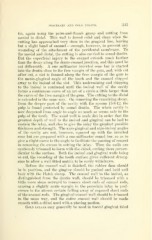Page 685 - My FlipBook
P. 685
PORCELAIN AND GOLD INLAYS. 343
tin, again using the palm-and-thumb grasp and cutting from
mesial to distal. This wall is found solid and clean when the
cutting has approached very close to the gingival line, leaving
but a slight band of enamel — enough, however, to prevent any
wounding of the attachment of the peridental membrane. To
the mesial and distal, the cutting is also carried to sound dentin.
But the superficial injury to the enamel extends much farther
than the decay along the dento-enamel junction, and this must be
cut differently. A one millimeter inverted cone bur is started
into the dentin close to the free margin of the gum, and, with cut
after cut, a slot is formed along the free margin of the gum to
the mesio-gingival angle of the tooth and the enamel chipped
away to the incisal of the slot. This undermining and chipping
to the incisal is continued until the incisal wall of the cavity
forms a continuous curve of an arc of a circle a little larger than
the curve of the free margin of the gum. The cutting to the distal
is extended in the same way. On removing the remaining decay,
from the deeper part of the cavity with the spoons 15-8-12, the
pulp is found protected by sound dentin. The whole cavity is
now deepened from angle to angle as much as seems safe to the
pulp of the tooth. The axial wall is made flat in order that the
greatest depth of wall to the incisal and gingival can be had to
sustain the inlay, and also to give the inlay the greatest possible
thickness and strength. The axio-gingival and axio-incisal angles
of the cavity are not, however, squared up with the inverted
cone but are prepared with a one-millimeter round bur, so as to
give a slight curve to the angle to facilitate the passing of cement
in removing the excess in setting the inlay. Then the walls are
cautiously trimmed to form with the chisel, cutting them perpen-
dicular to the surface. Both the incisal and gingival walls being
so cut, the rounding of the tooth surface gives sufficient diverg-
ence to allow a well-fitted matrix to be easily withdrawn.
Before the enamel wall is finished, the rubber dam should
be in position, and the gingiviB should be pushed and held well
back with the Hatch clamp. The enamel wall to the incisal, as
distinguished from the dentin wall, should be trimmed with a
little more slope outward to remove short ends of enamel rods,
causing a slightly acute margin in the porcelain inlay in pref-
erence to the almost certain falling away of exposed short ends
of the enamel rods. The gingival enamel wall should be trimmed
in the same way, and the entire enamel wall should be made
smooth with a chisel used with a planing motion.
Gold inlays may generally be used in buccal gingival third


